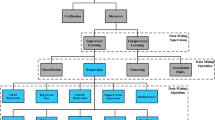Abstract
A property of data on the exact solution of the logistic curve model was exposed by behavior of upper limits estimated with an unsuitable model (the Gompertz curve model). The property is that the upper limits estimated with the Gompertz curve model for logistic data change with the downward convex for the data as the data size increases, i.e., time elapses. This contributes to identifying a suitable model because the behavior is independent of noise included in actual data. A suitable model is indispensable for correct forecasts. The property was proved and the proof was accomplished thanks to difference equations that have exact solutions. Moreover, we analyzed how resistant the downward convex and monotonic decrease of the estimated upper limit were to noise included in actual data sets.


Similar content being viewed by others
References
Aggrey, S.: Comparison of three nonlinear and spline regression models for describing chicken growth curves. Poult. Sci. 81(12), 1782–1788 (2002)
Chu, W.L., Wu, F.S., Kao, K.S., Yen, D.C.: Diffusion of mobile telephony: an empirical study in Taiwan. Telecommun. Policy 33(9), 506–520 (2009)
Franses, P.H.: A method to select between Gompertz and logistic trend curves. Technol. Forecast. Soc. Change 46(1), 45–49 (1994)
Gregg, J., Hossel, C., Richardson, J.: Mathematical trend curves, an aid to forecasting. ICI Monograph 1. Oliver and Boyd (1964)
Gupta, R., Jain, K.: Diffusion of mobile telephony in India: an empirical study. Technol. Forecast. Soc. Change 79(4), 709–715 (2012)
Hirota, R.: Nonlinear partial difference equations. V. nonlinear equations reducible to linear equations. J. Phys. Soc. Jpn. 46(1), 312–319 (1979)
Hirota, R.: Lecture on discrete equations. Saiensu-sha (2000) (in Japanese)
Hirota, R., Takahashi, D.: Discrete and Ultradiscrete Systems. Kyoritsushuppan (2003) (in Japanese)
Knízetová, H., Hyánek, J., Kníze, B., Roubícek, J.: Analysis of growth curve of fowl. I. chickens. Br. Poult. Sci. 32(5), 1027–1038 (1991)
Kucharavy, D., Guio, R.D.: Application of logistic growth curve. Proc. Eng. 131, 280–290 (2015)
Lechman, E.: ICT Diffusion in Developing Countries: Towards a New Concept of Technological Takeoff. Springer, Berlin (2015)
Li, T.Y., Yorke, J.A.: Period three implies chaos. Am. Math. Mon. 82(10), 985–992 (1975)
Mar-Molinero, C.: Tractors in Spain: a logistic analysis. J. Oper. Res. Soc. 31(2), 141–152 (1980)
Martino, J.P.: A review of selected recent advances in technological forecasting. Technol. Forecast. Soc. Change 70(8), 719–733 (2003)
Meade, N.: The use of growth curves in forecasting market development-a review and appraisal. J. Forecast. 3(4), 429–451 (1984)
Mitsuhashi, T.: Software quality assurance—approach to statistical control. JUSE (1981) (in Japanese)
Morisita, M.: The fitting of the logistic equation to the rate of increase of population density. Res. Popul. Ecol. 7(1), 52–55 (1965)
Narinc, D., Karaman, E., Firat, M.Z., Aksoy, T.: Comparison of non-linear growth models to describe the growth in Japanese quail. J. Anim. Vet. Adv. 9(14), 1961–1966 (2010)
Nguimkeu, P.: A simple selection test between the Gompertz and logistic growth models. Technol. Forecast. Soc. Change 88(1), 98–105 (2014)
Roush, W., Branton, S.: A comparison of fitting growth models with a genetic algorithm and nonlinear regression. Poult. Sci. 84(3), 494–502 (2005)
Satoh, D.: A discrete Gompertz equation and a software reliability growth model. IEICE Trans. E83–D(7), 1508–1513 (2000)
Satoh, D.: A discrete Bass model and its parameter estimation. J. Oper. Res. Soc. Japan 44(1), 1–18 (2001)
Satoh, D., Matsumura, R.: Monotonic decrease of upper limit estimated using Gompertz model with data described using logistic model. Jpn. J. Ind. Appl. Math. 36(1), 79–96 (2019)
Satoh, D., Uchida, M.: Computer worm model describing infection via e-mail. Bull. Jpn. Soc. Ind. Appl. Math. 20(3), 50–55 (2010). (in Japanese)
Satoh, D., Yamada, S.: Discrete equations and software reliability growth models. In: Proceedings of 12th International Symposium on Software Reliability Engineering, pp. 176–184 (2001)
Satoh, D.: Model selection among growth curve models that have the same number of parameters. Cogent Mathem. Stat. (to appear)
Satoh, D., Yamada, S.: Parameter estimation of discrete logistic curve models for software reliability assessment. Jpn. J. Ind. Appl. Math. 19(1), 39–53 (2002)
The World Bank: Mobile cellular subscriptions per 100 people. http://databank.worldbank.org/data/ country/USA/556d8fa6/Popular_countries (2012)
Yamada, S.: Software Reliability Modeling -Fundamentals and Applications. Springer, Berlin (2014)
Yamakawa, P., Rees, G.H., Salas, J.M., Alva, N.: The diffusion of mobile telephones: an empirical analysis for Peru. Telecommun. Policy 37(6–7), 594–606 (2013)
Young, P., Ord, J.: Model selection and estimation for technological growth curves. Int. J. Forecast. 5(4), 501–513 (1989)
Acknowledgements
The author thanks Ryutaro Matsumura for the fruitful discussions they had.
Author information
Authors and Affiliations
Corresponding author
Additional information
Publisher's Note
Springer Nature remains neutral with regard to jurisdictional claims in published maps and institutional affiliations.
Appendix: Derivation of Eq. (77)
Appendix: Derivation of Eq. (77)
We show derivation of Eq. (77) [23]. From the property of simple linear regression, the following equation
holds because \(-B_n\) is the slope of the regression equation (Eq. (30)). Since function \(\log (\alpha +\beta \exp x)\) is strictly monotonically decreasing as x increases,
We obtain
because of Eqs. (35), (90), and (91). We obtain
from Eq. (90). The left-hand side of Eq. (93) is rewritten as
where we use Eq. (55). The right-hand side of Eq. (93) is rewritten as
where we also use Eqs. (55) and (56) in Eq. (95). Thus, we obtain
from Eqs. (94) and (95). Eq. (96) is rewritten as
where we use
About this article
Cite this article
Satoh, D. Property of logistic data exposed with Gompertz model and resistance to noise in actual data. Japan J. Indust. Appl. Math. 36, 937–957 (2019). https://doi.org/10.1007/s13160-019-00382-2
Received:
Revised:
Published:
Issue Date:
DOI: https://doi.org/10.1007/s13160-019-00382-2
Keywords
- Logistic curve model
- Gompertz curve model
- Model-identification
- Difference equation
- Exact solution
- Applied discrete systems




